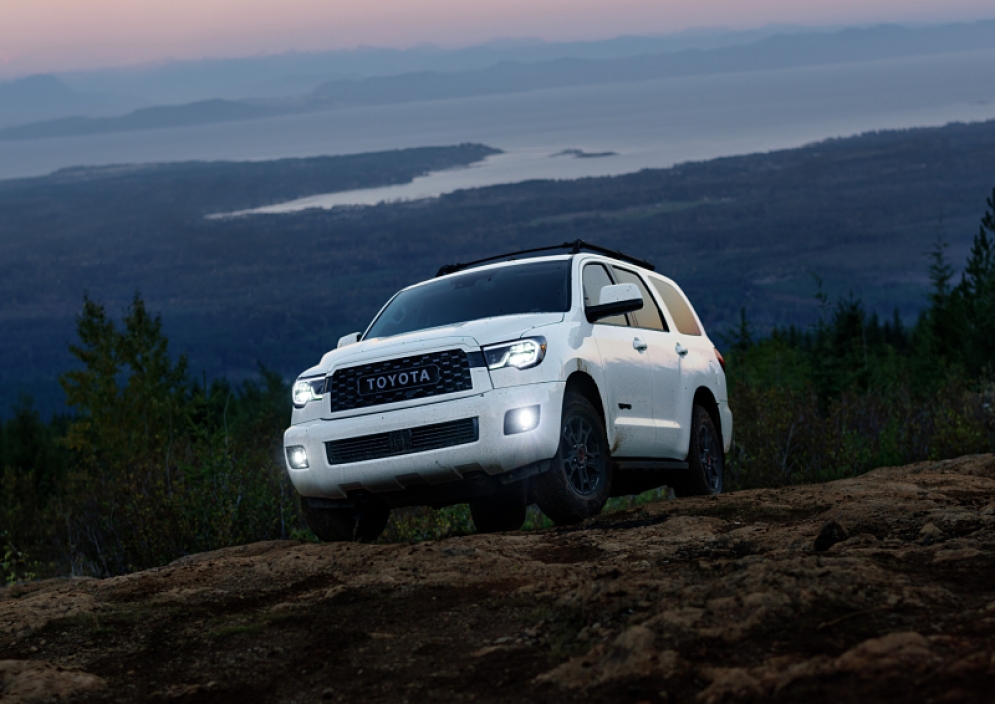Inside the vehicle, the Sequoia is extremely roomy, with seating for up to 8 people. And if you put some of those seats down you get major storage space, even more so than in the Land Cruiser. Cargo space numbers are 18.9 cubic feet with all three rows up, 66.6 cubic feet with the third row folded, and 120.1 cubic feet with both the second and third rows down. Those are some of the best numbers you’ll find in any vehicle and allow you transport whatever needs to be moved.
There are also some quality materials on the inside of the vehicle, but it’s not as upscale in look and feel as the Land Cruiser, which is to be expected due to the price difference. Still, for most people, the Sequoia's quality of materials will suffice.
My test vehicle featured 7 leather trimmed seats, but you can seat up to 8 with a second row bench seat instead of captain’s chairs.
Front row seats are heated, and you get three-zone climate control.
The Sequoia I tested was a TRD Pro version, and added features to boost off-road capability, including: 18-inch TRD Pro Wheels, LED Fog lights, Toyota Black Grille, Black Cast Aluminum Running Boards, TRD Front Skid Plate and Black Roof Rack. You can also add a TRD performance exhaust system.
A tow hitch receiver and 4/7 pin connector are also featured, and you get power folding outside mirrors and a tilt/slide moonroof with sunshade.
It’s immediately noticeable that the design inside Toyota’s large SUV lineup is not as modern looking as some of their competition. This is not unexpected, as Toyota tends to focus on reliability over staying on top of the latest design trends. The Sequoia hasn’t seen a major visual facelift since 2008, an eternity in car years, though one is expected for the 2022 model, when its visual cues will likely see a major shift from the current design.
HOW’S THE RIDE?
Just as the Sequoia looks like a tank, it also drives like a tank.
It's definitely powerful, but you're hauling nearly 3 tons of weight. So don't expect it to be super fast, or quick from a stop. The good news is that once you are moving, it will more quickly reach the higher speeds, so it operates well on the highway.
Power comes courtesy of a 5.7-liter V8 motor, boasting 381 horsepower and 401 pound-feet of torque (the same engine used in the Toyota Tundra pickup). The Sequoia also features multi-mode 4-Wheel Drive with a Locking Center Differential, a 6-speed automatic transmission, a front and rear independent double-wishbone suspension, and the TRD Pro model features TRD-tuned front and rear Fox shock absorbers.
The Sequoia can handle all types of weather, and is capable in most off-road situations (though it is less off-road capable overall than the Land Cruiser). For off-road adventures, the Sequoia offers part-time 4-wheel drive high and low, plus a locking center differential and a limited-slip rear differential. Upgrading to the Land Cruiser gets you full-time 4-wheel drive with selectable low-range, Toyota’s A-TRAC system that can mimic locking front and rear differentials, an automatic sway bar disconnect system, Crawl Control, Multi-Terrain Select and an off-road turn assist feature.
While I was driving the Sequoia, a healthy amount of snowfall came and I felt fully confident in my ability to get around town regardless of how the weather proceeded. If you live in an area where you have to be prepared for all possible weather scenarios, the Sequoia is one large SUV you should consider.
Towing is another strong point on the Sequoia, which can pull up to 7,400 pounds, enough to handle even a large boat or heavy trailer. The Sequoia also offers the TOW/HAUL mode, which allows the vehicle to level itself when it is towing.
TECHNOLOGY, SAFETY
As I mentioned earlier, the Sequoia lacks the modern flair of many large SUV competitors (i.e. the Chevy Suburban and Tahoe, or GMC Yukon), and that is very clear in the tech/infotainment setup.
The tech setup in front is very simple, with a 7-inch screen, but also works very well. You have the type of large circular dials which are often found in trucks. This fits well with the overall rugged look of the vehicle. Voice commands are clearly understood, and all the dials are very clearly labeled and easy to use. The navigation system also worked well.
The Sequoia also delivers in the safety department. For starters, you get the Toyota Safety Sense P system, which includes: Pre-Collision system with pedestrian detection, dynamic radar cruise control, lane departure alert and auto high beams.
Other helpful safety features include a blind spot monitor with rear cross traffic alert, a very helpful rear backup camera, trailer sway control, 8 airbags, and front and rear parking assist sonar. And you even get a power roll-down rear window, which is unique.
For sounds, you get a crisp-sounding JBL 14-speaker system. The Sequoia features 3 USB ports, Bluetooth connection for streaming music and phone calls, a 3-month free trial of satellite radio (which you’ll want to continue), and compatibility with Android Auto and Apple CarPlay for smartphone mirroring.
MPG
Official fuel economy numbers on the Sequoia are 13 mpg in the city, 17 mpg on the highway, and 14 mpg combined. In reality, while driving the Sequoia I averaged only 11.4 mpg.
Considering the size and weight of this type of vehicle, it’s easily one of the worst vehicles available for fuel mileage, right up there with the largest pickup trucks. Or to put it in real-world terms, I’ll quote the Monroney, which read: “You spend $7,000 more in fuel costs over 5 years vs. the average new vehicle.” Ouch.
While vehicles of this size generally aren’t purchased for fuel economy, these low numbers will no doubt be considered by potential Sequoia buyers when doing their financial calculations.
PRICE
The Sequoia I tested was priced just over $67,000, and base price starts about $50K; The TRD Pro model starts at $64K. While it lacks the more extensive off-road features and luxury design of the Land Cruiser, it’s also much cheaper (starting price for the Land Cruiser is about $85K), so making that leap is not worth it or possible for most buyers.
One other factor to consider is the overall reliability and longevity of Toyota vehicles. Many of these Sequoias are still going strong after 200,000 miles, which means they will last you many, many years — and certainly longer than many of its competitors. So don’t forget to factor that into your overall cost of ownership when deciding which large SUV is worth purchasing.
BOTTOM LINE
If you want a large SUV that looks and drives like a tank, is roomy inside, performs well in all weather, and is extremely reliable, the Sequoia should be on your list of vehicles to test. Its worst feature is the very low fuel mileage, but if you can get past that, the performance and versatility can’t be denied.
=====
AutoTechReviews.com can be found on Twitter @AutoTechReview, or stay updated at the AutoTechReviews Facebook page. Matt Myftiu can be found on Twitter @MattMyftiu.



